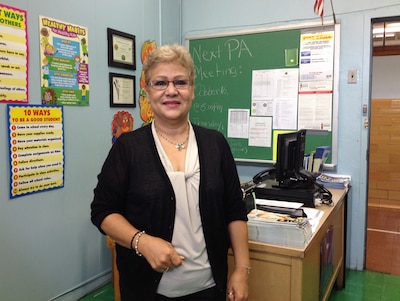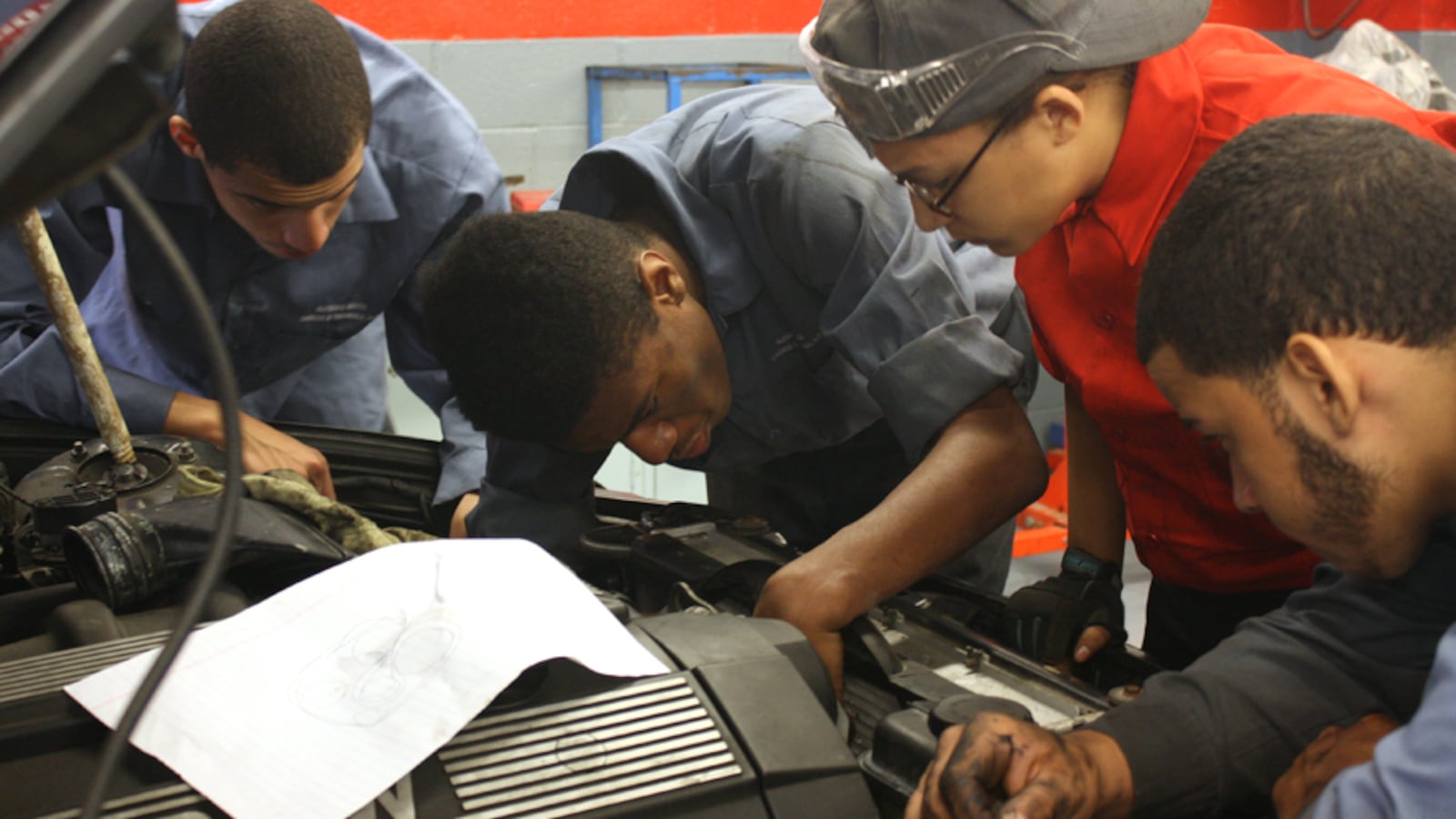During the summer of 2012, Evan Schwartz was getting ready to lead a brand-new school in the South Bronx.
The new school would replace Alfred E. Smith Career and Technical Education High School, a 950-student school that had struggled to graduate even half of its students for years. Schwartz, charged with replacing much of the staff, had invited about half of the staff to stay.
Things didn’t all go according to plan.
In late June 2012, an arbitrator ruled that the city could not shutter Smith and 23 other schools that officials had deemed low-performing enough to close. For teachers and students who had fought to save the school and its storied automotive-repair program, it was an unexpected victory. But the decision also meant the disintegration of Smith’s “turnaround” plan, which included a $3 million grant — and meant that many of those staff members would return after all.
Schwartz, though frustrated, decided to stay to see what he could do with the 82-year-old school. His goal: “Let’s take this name and build it back up,” he said.
Two years later, attendance rates and morale have crept up at the mostly-male school, teachers and students say. New equipment for the automotive program, and new uniforms that better disguise grease stains, have made their debuts. But the school remains on the state’s list of low-achieving schools, and graduation and Regents exam pass rates remain below city averages.
Smith’s story is an example of what it looks like to attempt to quickly improve a low-performing school, even as officials disagree over strategies and resources come and go. Its successes, and remaining challenges, are especially relevant as critics of the de Blasio administration continue their calls for a clearer plan for improving the city’s struggling schools.
Improvements at Smith
If you ask Schwartz what his vision is for the school, he’ll give you an acronym: BHAG, which stands for “big, hairy, audacious goal,” an phrase he borrowed from a book about the habits of successful companies.

His goal this year is to reach 90-80-70. That’s 90 percent attendance, 80 percent of first-year students earning 10 or more credits, and a 70 percent four-year graduation rate.
Smith has been known for its attendance problems — Schwartz said that in years past, you couldn’t tell when the day ended because students trickled in and out of the building all day — but last year, the attendance rate increased to 83 percent, according to his estimates. (Official numbers for last year are not yet available.) That’s up from 73 percent in 2011-12.
Graduation rates have been more stubborn. In 2012-13, Smith graduated just 51 percent of its students in four years, according to the city progress report, including August graduates. Last year, 61 percent of students graduated, Schwartz says.
That increase is likely related to the fact that the school convinced nearly 100 over-aged, under-credited students who attended class intermittently to transfer out of Smith and into transfer schools or more flexible Young Adult Borough Centers. One teacher said that these older students often stood at the end of the hallway in a group that was intimidating to younger classmates, something a number of the school’s current seniors also remembered.
Meanwhile, the school has shrunk dramatically. One of the city’s earlier plans was to improve the school by downsizing it, and more recently the school has struggled to attract students. Fewer than 400 students are enrolled this year, down from 950 the year before the proposed turnaround.
Students say the school is calmer now. Connie Jimenez, a senior and one of a few girls at the school, said that groups of boys would often surround and harass her in the hallways during her freshman year. “It was terrible,” she said.
While hallways are quieter, classroom experiences vary. In new, brightly lit classrooms in the basement one afternoon this October, students in AP English politely raised their hands to discuss “Beowulf,” and freshmen in earth science learned to use scales and rulers for lab work. In another earth science class down the hall, senior boys shouted randomly. They threw balled-up paper at each other’s heads and demanded to know why they hadn’t been given more time to study for a test that most of them had failed.
“Summer school is always an option,” their teacher told them.
Smith’s challenges
During the Bloomberg years, the city closed about 160 schools and replaced many larger high schools with smaller ones. Alfred E. Smith had already escaped closure once before it was slated for turnaround in 2012.
When the city proposed closing Smith again, “There was doom and gloom,” said Bruce Harris, an automotive teacher and 15-year Smith veteran. Even the decision that kept the school open brought troubles, many acknowledged.
“You don’t recover from that whiplash,” said Mary Conway-Spiegel, an advocate who has worked with a number of closing schools.
Smith faces challenges similar to those at struggling schools across the city: high percentages of English language learners and students with special needs, and the stigma of being a low-performing school for years. Almost 90 percent of students at Smith were eligible for free or reduced price lunch last year, according to Insideschools.

But Smith is unique among the 24 schools that avoided closure in 2012 because it has received significant new federal money to enact a new improvement plan.
Only handful of the other 23 received federal School Improvement Grants after the 2012 turnaround plan was nixed. Smith became a “transformation” school in 2013-14, and was awarded a total of $3 million over three years. Schwartz has used the money to bring on a full-time college and career guidance counselor, add after-school and tutoring programs, and hire additional teachers.
After the arbitrator’s decision, many teachers also left the school on their own. Schwartz said about five retired and nine were excessed because they had been teaching out of license.
That was less of a shake-up than would have happened through the initial turnaround plan, but those changes helped change the culture of the school, he said. “It was either, ‘Get on board, or you can move to a different place,’” Schwartz said.
Nilda Delgado, who has been the parent coordinator for 13 years, says the changes brought out tensions among teachers, especially in the first months. “There is still some resistance,” but not nearly as much, she said.
Now, the school sorts students into advisory periods that stay intact for a student’s four years. Teachers meet three times a week in grade-level and departmental groups, and outside consultants from Teachers College assist with Common Core-aligned unit planning. Schwartz also switched the dress code to darker colors, which showed auto-body grease stains less visibly — an indication to some teachers that the school administration was in touch with its main program.
Schools Chancellor Carmen Fariña has yet to outline formal plans for some of the city’s other struggling schools, but the de Blasio administration has resisted the idea that struggling schools should close. So while Smith likely won’t face closure again, next year will be the last year of its $3 million transformation grant — and it still has to find ways to continue to raise graduation rates and student achievement. Its latest college-and-career readiness rate, from 2011-12, stands at 6.6 percent.
“We’re more competitive now,” said Esteban Peralta, a senior in the automotive program, noting the school’s new AP classes. “We’re not progressing as fast, but we’re working on it.”


